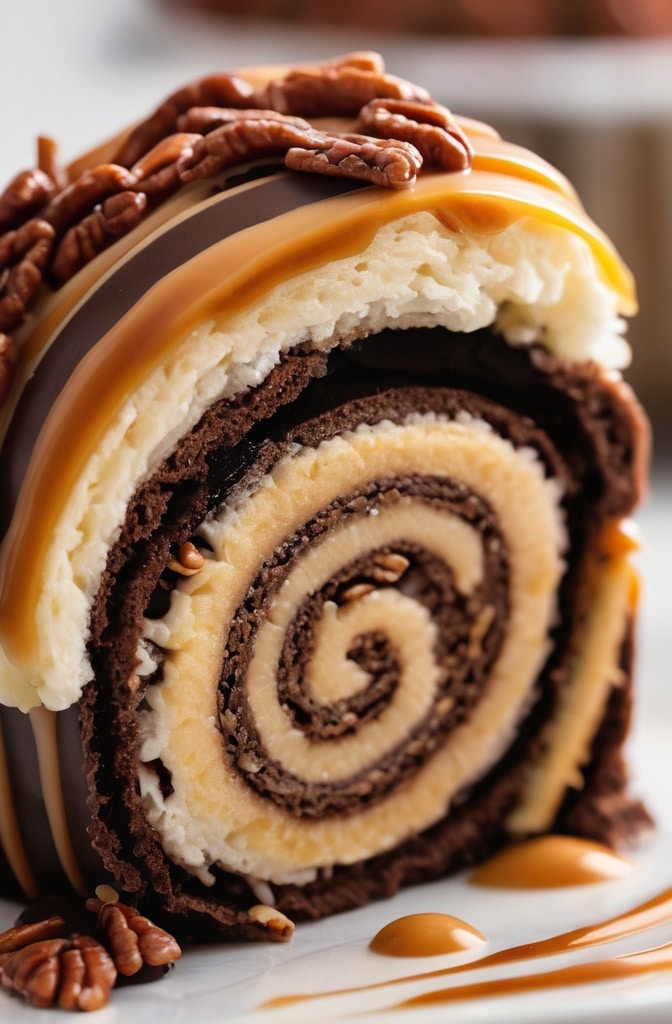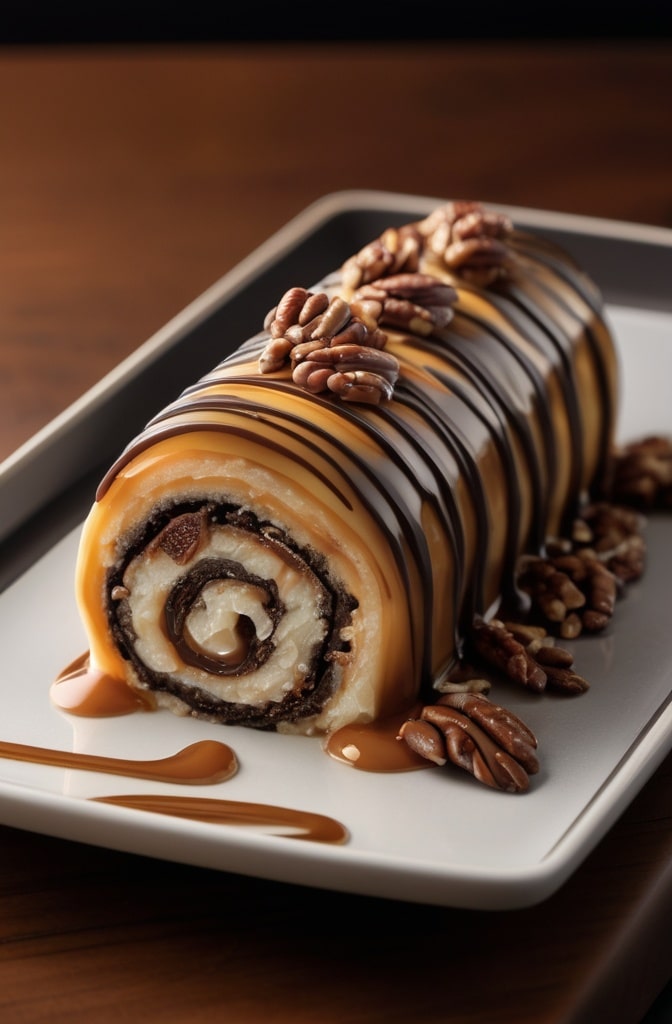The first time I attempted a chocolate roll cake, it cracked so badly my kitchen looked like an earthquake had struck. Twenty years and countless rolls later, I’ve mastered the art of these spiraled beauties. And lemme tell you this Chocolate Caramel Turtle Roll might just be the crown jewel of my repertoire.
With rich chocolate cake, gooey caramel, and crunchy pecans wrapped into one stunning dessert, this Chocolate Caramel Turtle Roll takes the classic turtle candy to a whole new level. It combines the beloved flavors of turtle candies with the elegant presentation of a Swiss roll. Pure magic.
What makes this recipe special is the balance between sophistication and accessibility. While it looks impressive enough for a high-end patisserie display case, the techniques aren’t beyond a dedicated home baker. The chocolate sponge remains impossibly tender while the salted caramel filling provides that irresistable sweet-salty contrast we all crave. Toasted pecans add textural intrigue that elevates each bite.
Ingredients & Substitutions
For the Chocolate Sponge Cake:
- 5 large eggs, room temperature (seperated)
- 3/4 cup granulated sugar, divided
- 1 teaspoon pure vanilla extract
- 1/2 cup cake flour
- 1/4 cup Dutch-processed cocoa powder
- 1/2 teaspoon baking powder
- 1/4 teaspoon fine sea salt
- 3 tablespoons unsalted butter, melted and cooled
For the Salted Caramel Filling:
- 1 cup granulated sugar
- 1/4 cup water
- 3/4 cup heavy cream, room temperature
- 4 tablespoons unsalted butter, cubed
- 1 teaspoon flaky sea salt (Maldon works briliant here)
- 1 teaspoon vanilla extract
- 8 oz mascarpone cheese, softened
- 1 cup toasted pecans, roughly chopped
For the Chocolate Ganache Glaze:
- 8 oz high-quality dark chocolate (65-70% cacao), finely chopped
- 1 cup heavy cream
- 2 tablespoons unsalted butter
- 1 tablespoon light corn syrup (creates that gorgeous shine)
- 1/2 teaspoon espresso powder (optional, enhances chocolate flavor)
For Garnish:
- 1/2 cup toasted pecans, chopped
- 2 tablespoons caramel sauce
- Flaky sea salt
The quality of chocolate makes an enormous difference in this recipe. I prefer Valrhona or Callebaut, but any high-quality chocolate with 65-70% cacao content will yield excellent results. For those with nut allergies, toasted pepitas (pumpkin seeds) provide a similar crunch without the allergen concern. Dairy-free? Coconut cream can replace heavy cream, and plant-based cream cheese works surprisingly well in place of mascarpone—though the filling will be slightly less stable.
Step-by-Step Instructions

Preparing the Chocolate Sponge:
- Preheat your oven to 350°F (175°C). Line a 15×10-inch jelly roll pan with parchment paper, leaving an overhang on the short sides. Lightly grease the parchment.
- In a medium bowl, sift together cake flour, cocoa powder, baking powder, and salt. Sifting is non-negotiable here—it prevents those dreaded cocoa lumps and ensures your cake rises evenly.
- In a large bowl, beat egg yolks with half the sugar (6 tablespoons) until pale and tripled in volume, about 4-5 minutes. The mixture should fall in thick ribbons when you lift the beater. Beat in vanilla extract.
- In a separate clean, grease-free bowl, whip egg whites until foamy. Gradually add remaining sugar and continue beating until medium-stiff peaks form. They should hold their shape but still have a slightly soft tip when you lift the beater.
- Gently fold the flour mixture into the yolk mixture in three additions. Many bakers rush this step, but patience preserves the air bubbles that give your sponge its lightness.
- Fold in about one-third of the whipped egg whites to lighten the batter, then carefully fold in the remaining whites until just combined. Drizzle melted butter around the edge of the bowl and fold in with minimal strokes.
- Spread batter evenly in prepared pan. Give the pan a couple sharp taps on the counter to release any large air bubbles. Bake for 10-12 minutes until the cake springs back when lightly touched. Don’t overbake or it’ll crack when rolled!
- While the cake bakes, lay a clean kitchen towel on your counter and dust generously with cocoa powder. This prevents sticking without adding dryness that powdered sugar might.
- When the cake comes out, immediately run a knife around the edges and invert onto the prepared towel. Peel off parchment paper carefully. Starting from short end, roll the cake up with the towel inside. Place seam-side down on a cooling rack and let cool completely, about 1 hour. This “trains” the cake to roll without cracking later.
Making the Salted Caramel Filling:
- In a heavy-bottomed saucepan, combine sugar and water, stirring just until sugar is moistened. Heat over medium-high heat without stirring (swirl the pan occasionally if needed) until mixture turns a deep amber color, about 8-10 minutes. Watch it like a hawk—the transition from perfect to burnt happens in seconds.
- Remove from heat and carefully add heavy cream (it will bubble vigorously). Return to low heat and whisk until smooth, then add butter, vanilla, and sea salt. Transfer to a heatproof bowl and let cool completely.
- Beat mascarpone cheese until smooth. Gradually add 3/4 cup of the cooled caramel (reserve remainder for garnish) and beat until well combined and fluffy, about 2 minutes. Fold in chopped toasted pecans.
Assembly:
- Carefully unroll the cooled cake. It may crack slightly at the initial curl—don’t panic, the filling will hide minor imperfections.
- Spread the caramel-mascarpone filling evenly over the cake, leaving a 1/2-inch border on all sides. The filling should be about 1/4-inch thick. Too thick and it’ll squish out; too thin and you’ll miss that luxurious creamy layer.
- Re-roll the cake (without the towel this time), starting from the same short end. Use the towel to help guide the roll and apply gentle, even pressure. Place seam-side down on a wire rack set over a baking sheet to catch drips during glazing.
- Chill for at least 1 hour to set the filling. This step is crucial—skimp on chilling time and your roll might unravel during glazing.
For the Chocolate Ganache Glaze:
- Place chopped chocolate in a heatproof bowl with espresso powder if using. In a small saucepan, heat cream just until it begins to simmer around the edges.
- Pour hot cream over chocolate and let stand for 30 seconds. Gently stir until chocolate is completely melted and mixture is smooth. Add butter and corn syrup, stirring until incorporated and glossy.
- Let ganache cool until slightly thickened but still pourable, about 10-15 minutes. It should coat the back of a spoon but still flow smoothly.
- Pour ganache evenly over the chilled cake roll, allowing it to drip down the sides. Use an offset spatula to ensure even coverage if needed.
- Before the ganache sets, sprinkle with chopped pecans. Drizzle with reserved caramel sauce and a light sprinkle of flaky sea salt.
- Return to refrigerator for at least 30 minutes to set the glaze before serving.
Cooking Techniques & Science
The success of this recipe hinges on several key techniques. The separate beating of egg yolks and whites creates a foam structure that gives the sponge its lightness. This technique, known in French pastry as “génoise,” relies on trapped air rather than chemical leaveners for most of its rise.
Rolling the cake while warm is essential because the proteins in the flour haven’t yet set completely. This is why hot bread is easier to tear than cooled bread—the protein structure is still pliable. Once the cake cools in the rolled position, those proteins “memorize” the shape, making the final rolling much less prone to cracking.

The caramel requires close attention to sugar chemistry. What’s happening is the sucrose molecules break down into glucose and fructose (inversion), then undergo further reactions that create hundreds of flavor compounds. This Maillard reaction is why caramel has such complex flavor notes. Adding cream stops the cooking process while also creating an emulsion. The addition of mascarpone stabilizes the filling thru its fat content and protein structure, preventing weeping.
The ganache glaze utilizes the perfect 2:1 ratio of chocolate to cream, creating that ideal texture that’s firm enough to set but soft enough to slice beautifully. The corn syrup prevents sugar crystallization, maintaining that mirror-like finish pastry chefs obsess over.
Serving & Pairing Suggestions
For optimal texture contrast, allow the roll to sit at room temperature for 15-20 minutes before serving. This brings the filling to the perfect consistency—too cold and the caramel becomes stiff; too warm and everything softens excessively.
Slice with a hot knife (run under hot water and wipe dry) for the cleanest cuts. A serrated knife works well too, using a gentle sawing motion rather than pressing down.
This dessert pairs magnificently with:
- A small scoop of vanilla bean ice cream for temperature contrast
- Espresso or French press coffee to balance the sweetness
- A tawny port or Pedro Ximénez sherry for an indulgent after-dinner experience
- Fresh raspberries or blackberries to cut through the richness
For an elevated presentation, place each slice on a pool of crème anglaise with a drizzle of additional caramel. A light dusting of gold luster dust on the pecans creates a show-stopping special occasion dessert.
Conclusion
The Chocolate Caramel Turtle Roll represents that perfect intersection of classical technique and comforting flavors. While it requires attention to detail, the result is well worth the effort—a professional-quality dessert that consistently impresses. The key to success lies in patience during the whipping and folding stages, proper rolling technique while the cake is warm, and allowing adequate chilling time between steps.
Don’t be intimidated by the multiple components; each can be prepared separately (the caramel sauce can even be made days ahead), making the process more manageable. Should disaster strike and your cake crack severely, remember the baker’s secret weapon—deconstruction! Layer the components in elegant glasses as a trifle and no one will be the wiser.
What I love most about this recipe is its versatility. Once you’ve mastered the fundamental techniques, you can adapt the flavors endlessly—try a white chocolate mousse filling with raspberry coulis, or a matcha sponge with black sesame cream. The possibilities are limitless, but this turtle variation remains my absolute favorite. Its balanced combination of textures and flavors creates something truly greater than the sum of its parts.
FAQs About Chocolate Caramel Turtle Roll
Can I make this recipe ahead of time?
Absolutely! The roll can be assembled and glazed up to two days in advance. Store it covered in the refrigerator, but allow it to sit at room temperature for 15-20 minutes before serving for the best texture and flavor. The unglazed roll can also be frozen for up to a month—just thaw overnight in the refrigerator before glazing.
Why did my cake crack when rolling?
Cracking typically occurs for three reasons: overbaking (making the cake too dry), cooling too much before initial rolling, or rolling too tightly. Ensure your cake is just baked through, roll it immediately while still hot, and use gentle pressure when rolling. Minor cracks will be hidden by the filling and glaze.
Can I use store-bought caramel sauce to save time?
You can, but the results won’t be quite the same. Homemade caramel has a complexity that store-bought varieties rarely achieve. If pressed for time, choose a high-quality caramel sauce and add a pinch of flaky sea salt to enhance the flavor profile.
How do I prevent the filling from oozing out the sides?
Chilling is your friend here. Make sure the filling is spreadable but not runny when assembling, leave that border around the edges, and chill the roll thoroughly before glazing. If you’re still having trouble, reduce the amount of filling slightly.
My ganache seized up and became grainy. What happened?
This typically happens when chocolate comes into contact with even small amounts of water or if the cream is too hot. Ensure all utensils are completely dry and heat the cream just until it simmers. If disaster strikes, you can sometimes rescue seized ganache by whisking in a tablespoon of boiling water or warm heavy cream.

